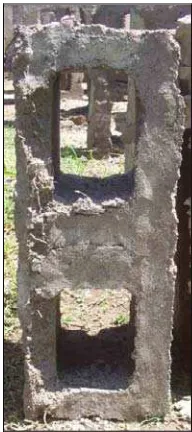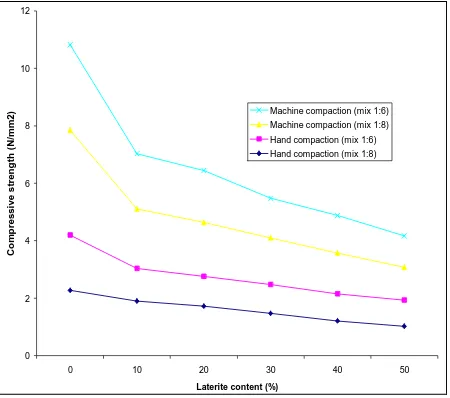15 Civil Engineering Dimension, Vol. 9, No. 1, 15–18, March 2007
ISSN 1410-9530
Civil Engineering Dimension ISSN 1410-9530 print © 2007 Thomson GaleTM
http://puslit.petra.ac.id/journals/civil
A STUDY OF COMPRESSIVE STRENGTH CHARACTERISTICS OF
LATERITE/SAND HOLLOW BLOCKS
Olugbenga Ata, Kolapo Olusola, Oludare Omojola, and Abiodun Olanipekun
Department of Building, Obafemi Awolowo University, Ile-Ife, Nigeria E-mail: [email protected]
ABSTRACT
This paper presents the results of experimental investigations carried out on partial replacement of sand with laterite as it affects the compressive strength of sandcrete hollow blocks. Two mix proportions (1:6 and 1:8) were used with laterite content varying between 0 and 50% at 10% intervals. Hand and machine compaction methods were used. Curing was done by sprinkling water on the specimens. The results showed that for each mix proportion and compaction method, the compressive strength decreases with increase in laterite content. Machine compacted hollow sandcrete blocks made from mix ratio 1:6 and with up to 10% laterite content is found suitable and hence recommended for building construction having attained a 28-day compressive strength of 2.07N/mm2 as required by the Nigerian Standards.
Keywords: compressive strength, laterite, sand, blocks, sandcrete.
INTRODUCTION
The urge to find alternative materials to existing conventional ones and the need to bring down the cost of construction have compelled researchers to intensify work on laterite with a view to inves-tigating their usefulness wholly as a construction material or partly as a substitute for fine aggregate component of concrete.
Sand supply is being threatened by a number of factors on one hand while its demand is increasing at alarming rate on the other hand. Increasing environmental consideration are among other factors besides being the only conventional fine aggregate that militate against supply of sand [1]. It has been observed that based on the nationwide availability of laterite, a fine aggregate, and the fact that it is being disposed as wastes on sites; laterite could either partially or wholly replace sand as fine aggregate.
Laterite has been used in construction of shelter from time immemorial and approximately 30% of world’s present population still lives in laterite structures [2]. It has been used extensively for wall construction around the world, particularly in developing countries [3]. Laterite is a cheap, environmentally friendly and abundantly available building material in the tropical region [4,5,6]. Laterite has other advantages which make it potentially a very good and appropriate material for construction, especially for the construction of rural structures in the less developed countries [7].
Note: Discussion is expected before June, 1st 2007, and will be published in the “Civil Engineering Dimension” volume 9, number 2, September 2007.
Received 29 March 2006; revised 31 May 2006, 30; accepted 30 July 2006.
These advantages include: no specialized skilled labour is required for the production of laterized concrete and for its use in the construction of structures and also, laterized concrete structures have potentially sufficient strength compared with that of normal concrete.
This study focuses attention on the compressive strength characteristics of sandcrete blocks in which sand is partially replaced with laterite.
EXPERIMENTAL PROGRAMME
Sharp sand, laterite and ordinary Portland cement are the major materials used in this investigation. All the materials were sourced from within Ile-Ife in Ife Central Local Government Area of Osun State, Nigeria. The maximum particle size of the fine aggregates (sand and laterite) used was 2.36mm.
O Ata, et. al./ A Study of Compressive Strength Characteristics of Laterite / CED, Vol. 9, No. 1, 15–18, March. 2007
16
commercial blocks in Nigeria. Manual compaction by hand ramming and machine compaction methods were used. Water sprinkling curing method was used.
Some selected samples of sand and laterite used as fine aggregate in this research work were subjected to various tests and analyses in order to ensure their compliance with various established standards. Sample grading, moisture content determination, specific gravity test and Atterberg limit determi-nation are some of the tests carried out on the samples.
The size of the block samples was 450x225x150mm. The variables studied were mix proportions at two levels (namely; mix proportions 1:6 and 1:8), method of compaction also at two levels (namely; mechanical and manual) and percentage laterite content at six levels (0%, 10%, 20%, 30%, 40% and 50%). The number of replicates tested was three in each case. Hence, a total number of 72 blocks in all were moulded manually and mechanically for both mix proportions at different laterite contents. The different mixtures of cement and the fine aggregates were “worked” manually by adding water to the mixture and continuously stirring with a spade.
For manual compaction, the equipment consists of a prefabricated steel mould box formed to the required dimensions. It is constructed such that after ramming the cement/aggregate mixture for the manufacture of blocks, the resulting shape exactly fits the mould and hence conforms to the dimensions required (450x225x150). A removable steel plate resting at the bottom allows removal of the compacted unit after hand ramming. Two curved steel handles on either side of the mould box aids the removal of the compacted unit.
The means of compaction is a wooden bat, in a shape of a chisel. The flat end of the bat is brought against the cement/aggregate mix, rammed over it and loaded into the steel mould. The compacted unit is removed by turning the box upside down and with impact. The opened end finally rests on a wooden pallet to receive the block. The removable steel plate that now lies on the upturned unit is removed.
The machine compacted equipment is built for easier use and can be operated by unskilled labour. It requires little maintenance and hence the design is very suitable for remote areas[8]. Both electric motors and diesel engines can support it. Its design principle includes the use of solid frames for safe handling and stability. Three levers operate it and produce a hydraulic pressure, which as constant. The framework is about 1.85m high.
It operates on a motor placed underneath the wooden pallet upon which the mould rests. The diesel types incorporate the use of a fan belt fixed over the motor and a roller, which actually turns the roller. Actual vibration occurs when the fixture on the motor, a metallic mass, hits underside of the wooden pallet. The moulded unit is removed by the operation of the longest lever, which is normally on the right side of the machine.
Figure 1. A Manually Operated Prefabricated Steel Mould Box
Figure 2. A Sample of 450x225x150mm Laterite/Sand Hollow Block
O Ata, et. al./ A Study of Compressive Strength Characteristics of Laterite / CED, Vol. 9, No. 1, 15–18, March. 2007
17 Figure 4. Crushing of A Block Sample in A Compression
Machine
Actual compaction is achieved by bringing the “presser” down to bear on the cement/aggregate mixture in the mould below. This is done by the operation of the highest lever. A second lever turns off the vibration. The operation of the last lever, the longest on the right hand side slowly lifts the mould for a quick removal of the compact unit. Pressure applied is fairly constant.
The compressive strength test was carried out at 28-day curing age using ELE 2000kN compressive testing machine. Three specimens for each mix proportion, compaction method and the six different percentage laterite contents were crushed. All crushings were done on the edge face with a 3mm thick flat steel plate placed at top and bottom of sample for even distribution of load. The compressive strength was then calculated for each block sample.
0
) Machine compaction (mix 1:6) Machine compaction (mix 1:8) Hand compaction (mix 1:6) Hand compaction (mix 1:8)
Figure 5. Compressive Strength Versus Laterite Content
RESULTS AND DISCUSSION
The compressive strength variations at various levels of percentage replacement of sand with
laterite for both mix ratios are shown in Figure 5. Test results show that the compressive strength of sandcrete block decreases at a decreasing rate as percentage laterite content increases. For example, the rate of change of change of compressive between 0% and 10% laterite is higher than the rate of change of compressive strength between 10% and 20% laterite content. This may not be unconnected with the fact that sand contains mainly silica in the form of quartz which is a very hard material, hence the higher compressive strength material end product obtained when it combines with cement in comparison with laterite which contains less of silica.
It was also observed that the ease of compaction and moulding decrease and thus the time it takes to mould one lateritic block increases as the percentage of laterite content increases. In other words, the more laterite content in the mix, the more difficult and the longer time it takes to mould. This is due to the high plasticity of laterite.
The figure also shows that machine compacted blocks have higher compressive strengths than hand compacted blocks. The difference is very pronounced at low percentage laterite content but becomes less pronounced as percentage laterite content increases. This is probably due to higher compaction pressure achieved with the former.
CONCLUSION AND RECOMMENDATIONS
A study of compressive strength characteristics of laterite/sand blocks has been carried out. Generally, the compressive strength of sandcrete blocks decreases as the percentage of laterite content increases. The method of compaction used has a significant influence on the compressive strength of the block. The blocks produced by machine compac-tion method have higher compressive strength than the blocks produced by hand compaction method. Machine compacted sandcrete hollow blocks made from mix ratio 1:6 and with up to 10% laterite content is found suitable and hence recommend for building construction having attained a 28-day
compressive strength of 2.07N/mm2 as required by
the Nigerian Standards.
It is further noted that the strengths achieved in this study makes cement laterite/sand blocks suitable for non-load bearing masonry construction with up to 30% replacement level of sand with laterite.
Acknowledgement
O Ata, et. al./ A Study of Compressive Strength Characteristics of Laterite / CED, Vol. 9, No. 1, 15–18, March. 2007
18
REFERENCES
1. Ata, O., Olusola, K.O., and Aina, O.O., Factors Affecting Poisson’s Ratio of Laterized Concrete,
Jurnal Sains Dan Teknologi, EMAS, 15(2), 2005, pp.77-84.
2. Cofirman, R., Agnew, N, Auiston, G and Doehne, E., Adobe Mineralogy: Characterisation of Adobes
from Around the World, 6th International
Con-ference on the Conservation of Earthen
Architec-ture, Las Cruces, NM; 14-19 October, 1990.
3. Ren, K.B and Kagi, D.S., Upgrading the
Dura-bility of Mud Bricks by Impregnation, Build
Build Environ, 30(3), 1995, pp.440.
4. Ata, O., Effect of Applied Stress on Moduli of
Elasticity and Deformability of Terracrete, Un-published M.Sc. Thesis Submitted to the Depart-ment of Building, Obafemi Awolowo University, Ile-Ife, 2003.
5. Olusola, K.O., Some Factors Affecting
Compres-sive Strength and Elastic Properties of Laterized Concrete, Unpublished Ph.D. Thesis Submitted to the Department of Building, Obafemi Awolowo University, Ile-Ife, 2005.
6. Binici, H., Aksogan, O., and Shan, T. Investigati-on of Fibre Reinforced Mud Brick as a Building
Material, Construction and Building Materials,
19(2), 2004, pp.313-318.
7. Osunade, J.A., Effect of Replacement of Laterite Soils with Granite Fines on the Compressive and
Tensile Strengths of Laterized Concrete, Building
and Environment, 37(5), 2002, pp.491-496.
8. Baiden, B.K. and Asante, C.K.O., Effects of Orientation and Compaction Methods of Manu-facture on Strength Properties of Sandcrete
Blocks, Construction and Building Materials,

